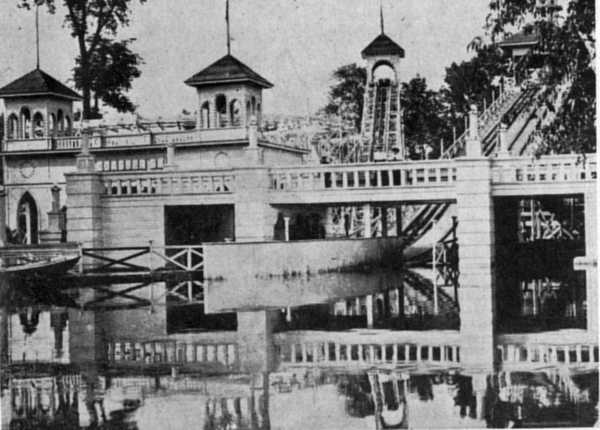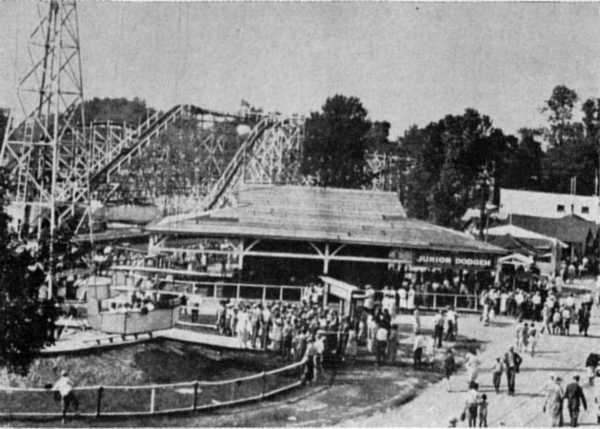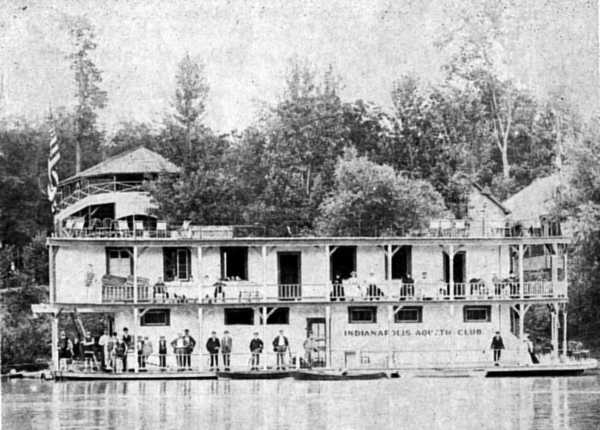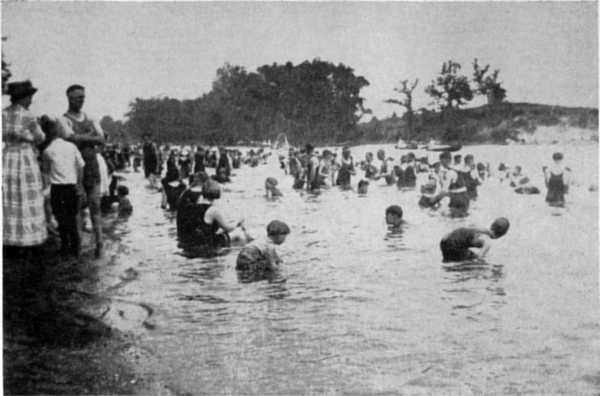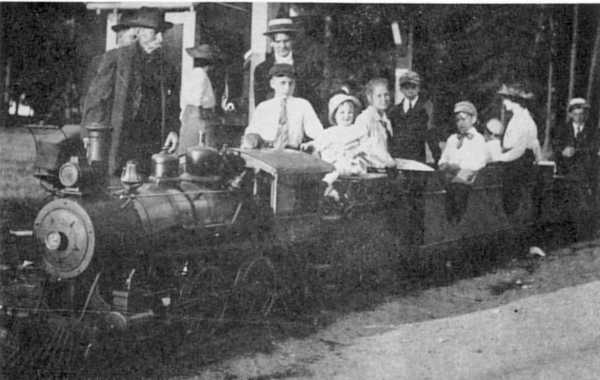|
Chapter Eleven
Park attracts tourists
Broad Ripple became famous as a recreational and amusement center in the 1900's. Residents of Indianapolis built resort cabins and cottages along White River for three miles upstream from Broad Ripple. Soon resort areas such as Idlewood, Terrace Beach, Ravenswood, and Wildwood developed. The cottages were given clever names such as "Dew Drop Inn." There was daily service by row boat or motor launch to provide the cottages with ice, food, and other provisions. The town of Broad Ripple itself, however, was not the principal drawing place of the northern area of Indianapolis. Broad Ripple Park was the real center of social life in Broad Ripple and was noted all over the country. Broad Ripple Park had its beginning when Jonas Huffman received a 60.05 acre tract of land north of Indianapolis from the United States government on September 16, 1822. Later, the Huffman farm owned by James Huffman, Jonas' son, and Charles Dawson was visited by picnickers from miles around. By 1866, the Dawson family had taken over full ownership of the land and maintained it until 1904, except for a strip of land along the river which was sold to the Broad Ripple Transit Company in 1902. In 1904, Morton and Stanton, two building contractors, bought the land and began construction of the park. In 1907, the park became the great amusement center known as White City when the White City Company of Indianapolis, owned by W. H. Tabb and Dr. Robert C. Light, leased the park for nine years. The park was given the nickname of Broad Ripple Park since it was located on the outskirts of that community, and about 100 people from the village were employed there. The White City company added many facilities to the park, giving it the appearance of Coney Island. Along the 500-foot boardwalk and the 230-foot cement walk on the west side of the park, there were a dance hall, a restaurant, a lunch counter, a photo gallery, a penny arcade, an airship, a soda fountain, and a myth city. At the park's north end, there were exits to the river, boathouses, and a 40' x 785' romantic board walk extending over the water. A Venetian canal, a fire show, a scenic railroad, an 80'x 100' concrete Natatorium or pool, and an open circus were located on the northeast side of the park. Amusements in the east section of the City included the "bump-the-bump," bowling alleys, the "Johnstown Flood," the Theaters of Paris, carousels, and other midway rides. One of the unique features of White City was the exhibit in which white horses jumped from an elevated platform into a tank of water. The park attractions were situated around a five hundred foot center court containing many concession stands. A 250'x 100' lagoon was situated at the court's north end. The lagoon was spanned by a bridge, under which the "chutes" passed. In addition to the amusement park attractions, there were also picnic facilities. On Sunday afternoons during the spring and summer, families from all around the Broad Ripple area would come to the park for a picnic lunch and an afternoon of entertainment.
Magnificent White City Park, built by the White City Company of Indianapolis, owned by Dr. Robert C. Light and W. H. Tabb, burned in 1908. Having no insurance, the owners were forced to sell. The Union Traction Company bought the park on March 6, 1911. This company, which retained ownership of the park for eleven years, rebuilt it and restored many of the old amusements. Several new attractions were also added. During the summer months, the City billed such shows as a man wrestling a live alligator. There were also entertainers who drank milk and ate fruit under water. In 1908, the White City Company built the second largest swimming pool in the country. In 1922, the National Swimming Event took place in the Broad Ripple pool, and, in 1924, the Oympic tryouts were there. At this meet, Johnny Weissmuller won the one-hundred-meter freestyle and later went on to win a gold medal at the Olympics. Again in 1952, the Olympic tryouts were at Broad Ripple pool. Judy Roberts, 1952 Broad Ripple High School graduate, was chosen as a member of the US Olympic Swim Team which competed at Helsinki. In 1922, the Broad Ripple Amusement Company bought the park from the Traction Company; and at this time the name was changed from White City to Broad Ripple Park. Also at this time, two baseball diamonds, a football field, a cinder track, and two bath houses were added under the direction of James A. Makin, later the founder of the Riviera Club. A giant roller coaster was also added to the park. In 1927, the park was sold to Oscar and Joseph Baur. Many of the rebuilt rides of 1908 were removed to enlarge the midway. New amusements such as the Temple of Mystery, the "dodg'em," and Huffman's Auto Speedway were also added. In the same year, the pool was remodeled. A well was also dug so that river water would not have to be used to fill the pool. The price of admission was increased from 15 to 25 cents for adults and from 5 to 10 cents for children. In 1938, W. A. McCurry bought the park, and on December 21, 1945, the park was purchased by the city of Indianapolis.
Canoeing was a great attraction, and as a result of this great interest the Green City, Aquatic, and Broad Ripple boat clubs were formed. River steamers were also a major attraction during this period. The Sunshine, which was probably the best known steamer, was shipped to Broad Ripple from Eagle Lake near Warsaw, Indiana, in 1897. Frank Norvial was the captain from 1897-1905. The Sunshine was first owned by Denny Sullivan who also owned the Green City canoe and rowboat houses located where the Weaver Garden Shop now stands. The Union Traction Company bought the boat along with Broad Ripple Park in 1911. This 30-50 passenger boat usually traveled about 4 1/2 - 5 miles north on White River from Broad Ripple Park. On the weekends, the Sunshine made a shorter trip to the Haverstick farms, two miles up the river. Several disasters marked the Sunshine's life. In 1904, the Sunshine sank after hitting an underwater ice mass. The boat was raised and restored, only to sink again on August 7, 1905. This disaster was believed to have been caused by the collapse of the overloaded top deck. The boat was returning from the Haverstick farms when a sudden shift of the crowd on the top deck resulted in the breakage of the paddle wheel chain, causing the boat to list to one side. Captain H. S. Crockett warned the passengers of the boat's leaning, but to no avail. At this time the pilot, "Dutch" Metzger, headed the ship for the west bank of White River. A second list occurred when a girl waving a handkerchief went by in a canoe. All of the men aboard the Sunshine rushed to that side of the boat to see her, and while only a few feet from the shore, the Sunshine sank. The Moonriver, a later excursion boat, had a speciality of serving smoked hickory ribs that were barbecued in special pits at each end of the upper deck. The boat continued its cruises until 1938. The Perseverance was another White River steamer at this time. Built by John Fitch, the Perseverance performed the unique act of unexpectedly diving over the Broad Ripple dam without a single loss of life.

Contents
|
